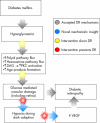Spare the rod and spoil the eye
- PMID: 15923516
- PMCID: PMC1772679
- DOI: 10.1136/bjo.2004.062547
Spare the rod and spoil the eye
Abstract
This review presents a new unified view of the pathogenesis of three common causes of acquired retinal degenerative disease-diabetic retinopathy, age related macular degeneration, and retinopathy of prematurity. In these three conditions, angiogenesis has a predominant role in the development of sight threatening pathology. Angiogenesis is controlled by among other factors the expression of vascular endothelial growth factor (VEGF), which in turn is regulated by absolute and relative lack of oxygen. The severe pathological manifestations of these three conditions are not part of a general underlying disease process because they are peculiar to the eye, and the profound hypoxia that develops in normal retina during dark adaptation (rod driven hypoxia) is an adequate and elegant additional factor to explain their pathogenesis. A large number of experimental reports support this conclusion, although rod driven anoxia is not generally considered as a causal factor in ocular disease. However, the hypothesis can be critically tested, and also suggests novel methods of treatment and prevention of these conditions that may be simpler and more inexpensive than current therapies and that have a smaller potential for adverse effects.
Figures
References
-
- Witmer AN, Vrensen GFJM, Van Noorden CJF, et al. Vascular endothelial growth factors and angiogenesis in eye disease. Prog Retin Eye Res 2003;22:1–29. - PubMed
-
- Pugh ENJ, Nikonov S, Lamb TD. Molecular mechanisms of vertebrate photoreceptor light adaptation. Curr Opin Neurobiol 1999;9:410–18. - PubMed
-
- Ebrey T, Koutalos Y. Vertebrate photoreceptors. Prog Ret Eye Res 2001;20:49–94. - PubMed
Publication types
MeSH terms
Substances
LinkOut - more resources
Full Text Sources
Other Literature Sources
Medical

